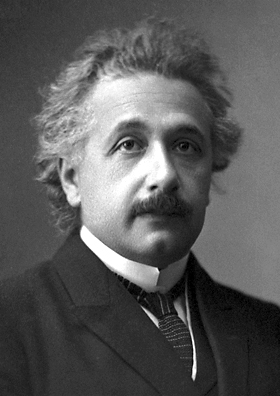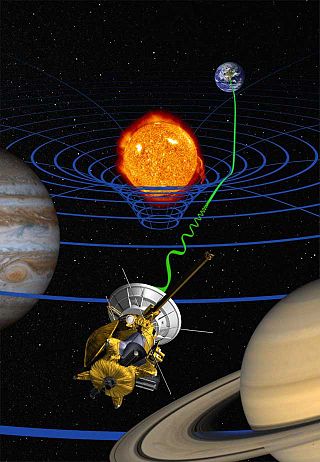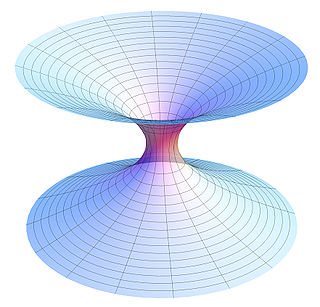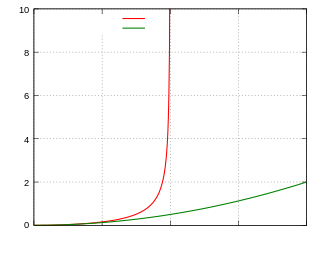See also
| Classical physics | |
|---|---|
| Modern physics |
|
| Recent developments |
|
| On specific discoveries |
|
| By periods | |
| By groups | |
| Scientific disputes | |
This is a list of notable experiments in physics. The list includes only experiments with Wikipedia articles. For hypothetical experiments, see thought experiment.

General relativity, also known as the general theory of relativity and Einstein's theory of gravity, is the geometric theory of gravitation published by Albert Einstein in 1915 and is the current description of gravitation in modern physics. General relativity generalises special relativity and refines Newton's law of universal gravitation, providing a unified description of gravity as a geometric property of space and time or four-dimensional spacetime. In particular, the curvature of spacetime is directly related to the energy and momentum of whatever matter and radiation are present. The relation is specified by the Einstein field equations, a system of second order partial differential equations.

Physics is the natural science of matter, involving the study of matter, its fundamental constituents, its motion and behavior through space and time, and the related entities of energy and force. Physics is one of the most fundamental scientific disciplines, with its main goal being to understand how the universe behaves. A scientist who specializes in the field of physics is called a physicist.

In physics, the special theory of relativity, or special relativity for short, is a scientific theory of the relationship between space and time. In Albert Einstein's 1905 treatment, the theory is presented as being based on just two postulates:

The theory of relativity usually encompasses two interrelated physics theories by Albert Einstein: special relativity and general relativity, proposed and published in 1905 and 1915, respectively. Special relativity applies to all physical phenomena in the absence of gravity. General relativity explains the law of gravitation and its relation to the forces of nature. It applies to the cosmological and astrophysical realm, including astronomy.
In physics, the principle of relativity is the requirement that the equations describing the laws of physics have the same form in all admissible frames of reference.

The Hafele–Keating experiment was a test of the theory of relativity. In 1971, Joseph C. Hafele, a physicist, and Richard E. Keating, an astronomer, took four caesium-beam atomic clocks aboard commercial airliners. They flew twice around the world, first eastward, then westward, and compared the clocks in motion to stationary clocks at the United States Naval Observatory. When reunited, the three sets of clocks were found to disagree with one another, and their differences were consistent with the predictions of special and general relativity.
Experimental physics is the category of disciplines and sub-disciplines in the field of physics that are concerned with the observation of physical phenomena and experiments. Methods vary from discipline to discipline, from simple experiments and observations, such as Galileo's experiments, to more complicated ones, such as the Large Hadron Collider.

Modern physics is a branch of physics that developed in the early 20th century and onward or branches greatly influenced by early 20th century physics. Notable branches of modern physics include quantum mechanics, special relativity and general relativity.

The equivalence principle is the hypothesis that the observed equivalence of gravitational and inertial mass is a consequence of nature. The weak form, known for centuries, relates to masses of any composition in free fall taking the same trajectories and landing at identical times. The extended form by Albert Einstein requires special relativity to also hold in free fall and requires the weak equivalence to be valid everywhere. This form was a critical input for the development of the theory of general relativity. The strong form requires Einstein's form to work for stellar objects. Highly precise experimental tests of the principle limit possible deviations from equivalence to very small.

General relativity is a theory of gravitation developed by Albert Einstein between 1907 and 1915. The theory of general relativity says that the observed gravitational effect between masses results from their warping of spacetime.
Special relativity is a physical theory that plays a fundamental role in the description of all physical phenomena, as long as gravitation is not significant. Many experiments played an important role in its development and justification. The strength of the theory lies in its unique ability to correctly predict to high precision the outcome of an extremely diverse range of experiments. Repeats of many of those experiments are still being conducted with steadily increased precision, with modern experiments focusing on effects such as at the Planck scale and in the neutrino sector. Their results are consistent with the predictions of special relativity. Collections of various tests were given by Jakob Laub, Zhang, Mattingly, Clifford Will, and Roberts/Schleif.
Tests of general relativity serve to establish observational evidence for the theory of general relativity. The first three tests, proposed by Albert Einstein in 1915, concerned the "anomalous" precession of the perihelion of Mercury, the bending of light in gravitational fields, and the gravitational redshift. The precession of Mercury was already known; experiments showing light bending in accordance with the predictions of general relativity were performed in 1919, with increasingly precise measurements made in subsequent tests; and scientists claimed to have measured the gravitational redshift in 1925, although measurements sensitive enough to actually confirm the theory were not made until 1954. A more accurate program starting in 1959 tested general relativity in the weak gravitational field limit, severely limiting possible deviations from the theory.
Autodynamics was a physics theory proposed by Ricardo Carezani (1921–2016) in the early 1940s as a replacement for Einstein's theories of special relativity and general relativity. Autodynamics never gained status as a viable alternative model within the physics community, and today is wholly rejected by mainstream science.
Bruno Bertotti was an Italian physicist, emeritus professor at the University of Pavia. He was one of the last students of physicist Erwin Schrödinger.
Clifford Martin Will is a Canadian-born theoretical physicist noted for his contributions to general relativity.
Test theories of special relativity give a mathematical framework for analyzing results of experiments to verify special relativity.

Theoretical physics is a branch of physics that employs mathematical models and abstractions of physical objects and systems to rationalize, explain and predict natural phenomena. This is in contrast to experimental physics, which uses experimental tools to probe these phenomena.
Standard-Model Extension (SME) is an effective field theory that contains the Standard Model, general relativity, and all possible operators that break Lorentz symmetry. Violations of this fundamental symmetry can be studied within this general framework. CPT violation implies the breaking of Lorentz symmetry, and the SME includes operators that both break and preserve CPT symmetry.

Tests of relativistic energy and momentum are aimed at measuring the relativistic expressions for energy, momentum, and mass. According to special relativity, the properties of particles moving approximately at the speed of light significantly deviate from the predictions of Newtonian mechanics. For instance, the speed of light cannot be reached by massive particles.